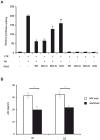HIV-1 Tat binds to SH3 domains: cellular and viral outcome of Tat/Grb2 interaction
- PMID: 21745501
- PMCID: PMC3527102
- DOI: 10.1016/j.bbamcr.2011.06.012
HIV-1 Tat binds to SH3 domains: cellular and viral outcome of Tat/Grb2 interaction
Abstract
The Src-homology 3 (SH3) domain is one of the most frequent protein recognition modules (PRMs), being represented in signal transduction pathways and in several pathologies such as cancer and AIDS. Grb2 (growth factor receptor-bound protein 2) is an adaptor protein that contains two SH3 domains and is involved in receptor tyrosine kinase (RTK) signal transduction pathways. The HIV-1 transactivator factor Tat is required for viral replication and it has been shown to bind directly or indirectly to several host proteins, deregulating their functions. In this study, we show interaction between the cellular factor Grb2 and the HIV-1 trans-activating protein Tat. The binding is mediated by the proline-rich sequence of Tat and the SH3 domain of Grb2. As the adaptor protein Grb2 participates in a wide variety of signaling pathways, we characterized at least one of the possible downstream effects of the Tat/Grb2 interaction on the well-known IGF-1R/Raf/MAPK cascade. We show that the binding of Tat to Grb2 impairs activation of the Raf/MAPK pathway, while potentiating the PKA/Raf inhibitory pathway. The Tat/Grb2 interaction affects also viral function by inhibiting the Tat-mediated transactivation of HIV-1 LTR and viral replication in infected primary microglia.
Copyright © 2011 Elsevier B.V. All rights reserved.
Figures








Similar articles
-
NS5A, a nonstructural protein of hepatitis C virus, binds growth factor receptor-bound protein 2 adaptor protein in a Src homology 3 domain/ligand-dependent manner and perturbs mitogenic signaling.Proc Natl Acad Sci U S A. 1999 May 11;96(10):5533-8. doi: 10.1073/pnas.96.10.5533. Proc Natl Acad Sci U S A. 1999. PMID: 10318918 Free PMC article.
-
Sprouty2 binds Grb2 at two different proline-rich regions, and the mechanism of ERK inhibition is independent of this interaction.Cell Signal. 2007 Nov;19(11):2277-85. doi: 10.1016/j.cellsig.2007.07.008. Epub 2007 Jul 14. Cell Signal. 2007. PMID: 17689925
-
GAREM, a novel adaptor protein for growth factor receptor-bound protein 2, contributes to cellular transformation through the activation of extracellular signal-regulated kinase signaling.J Biol Chem. 2009 Jul 24;284(30):20206-14. doi: 10.1074/jbc.M109.021139. Epub 2009 Jun 9. J Biol Chem. 2009. PMID: 19509291 Free PMC article.
-
The Role of Grb2 in Cancer and Peptides as Grb2 Antagonists.Protein Pept Lett. 2018 Feb 8;24(12):1084-1095. doi: 10.2174/0929866525666171123213148. Protein Pept Lett. 2018. PMID: 29173143 Review.
-
Tat basic domain: A "Swiss army knife" of HIV-1 Tat?Rev Med Virol. 2019 Mar;29(2):e2031. doi: 10.1002/rmv.2031. Epub 2019 Jan 4. Rev Med Virol. 2019. PMID: 30609200 Review.
Cited by
-
Identification of novel HIV-1 dependency factors in primary CCR4(+)CCR6(+)Th17 cells via a genome-wide transcriptional approach.Retrovirology. 2015 Dec 10;12:102. doi: 10.1186/s12977-015-0226-9. Retrovirology. 2015. PMID: 26654242 Free PMC article.
-
Neuroprotective effects of the anti-cancer drug sunitinib in models of HIV neurotoxicity suggests potential for the treatment of neurodegenerative disorders.Br J Pharmacol. 2014 Dec;171(24):5757-73. doi: 10.1111/bph.12875. Br J Pharmacol. 2014. PMID: 25117211 Free PMC article.
-
HIV-1-Tat Protein Inhibits SC35-mediated Tau Exon 10 Inclusion through Up-regulation of DYRK1A Kinase.J Biol Chem. 2015 Dec 25;290(52):30931-46. doi: 10.1074/jbc.M115.675751. Epub 2015 Nov 3. J Biol Chem. 2015. PMID: 26534959 Free PMC article.
-
The Dynamic Linkage between Provirus Integration Sites and the Host Functional Genome Property Alongside HIV-1 Infections Associated with Antiretroviral Therapy.Vaccines (Basel). 2023 Feb 9;11(2):402. doi: 10.3390/vaccines11020402. Vaccines (Basel). 2023. PMID: 36851277 Free PMC article.
-
Combination of HIV-1 and Diabetes Enhances Blood Brain Barrier Injury via Effects on Brain Endothelium and Pericytes.Int J Mol Sci. 2020 Jun 30;21(13):4663. doi: 10.3390/ijms21134663. Int J Mol Sci. 2020. PMID: 32630025 Free PMC article.
References
Publication types
MeSH terms
Substances
Grants and funding
LinkOut - more resources
Full Text Sources
Medical
Research Materials
Miscellaneous

